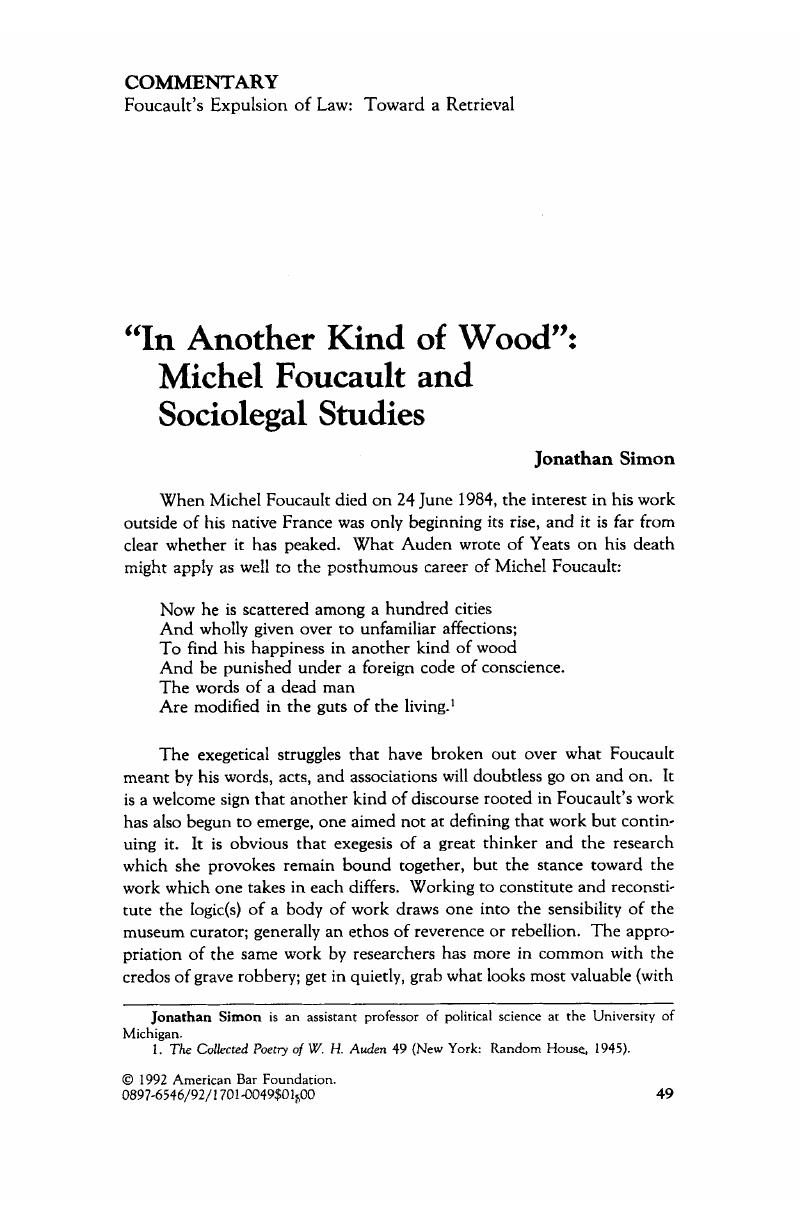No CrossRef data available.
Article contents
“In Another Kind of Wood”: Michel Foucault and Sociolegal Studies
Published online by Cambridge University Press: 27 December 2018
Abstract

- Type
- Commentary
- Information
- Copyright
- Copyright © American Bar Foundation, 1992
References
1 The Collected Poetry of W. H. Aden 49 (New York: Random House, 1945).Google Scholar
2 Alan Hunt, “Foucault's Expulsion of Law: Toward a Retrieval,” 17 Law & Soc. Inquiry 1 (1992).CrossRefGoogle Scholar
3 Trans. Alan Sheridan (New York: Pantheon Books, 1977). Already this is an interesting alternative to a more classically Marxian analysis of law as ideology in which law covers up relative power.Google Scholar
4 It may be possible to trace historically in the 19th century a process through which law first covered up but later engaged in rationalizing disciplinary power relations. Christopher Tomlins's important study of the disciplinary logic of the “Fellow Servant Rule” shows law covering up discipline during the quickening of the industrial era in America. See Tomlins, Christopher, “A Mysterious Power: Industrial Accidents and the Legal Construction of Employment Relations in Massachusetts, 1800–1850,” 6 Law & Hist. Rev. 375 (1988). My own examination of the latter development of the rule suggests that law became a much more active agent of disciplinary intensification during the 1870s and 1880s. See Simon, Jonathan, ‘The Government of Their Servants’: The Employers' Duty to Discipline and Govern Work, 1870–1920,”Studies in Law, Politics, and Society (forthcoming 1993).CrossRefGoogle Scholar
5 “The Sociology of Law,”in George Gurvitch & Wilbur Moore, eds., Readings in Sociology 300 (New York: Random House, 1945).Google Scholar
6 Hunt (at 33) acknowledges that this is a danger in the Gramscian notion of “hegemony” but feels that the risk is worth taking for the added ability to talk about causation.Google Scholar
7 Indeed, Hunt's efforts to clarify the meaning of “strategies” and “projects” and to utilize “structural coupling” are promising but difficult to evaluate without trying them on to see if they help us unpack the logic of specific historical and contemporary practice.Google Scholar
8 This is, of course, an old insight for sociolegal studies which has long been fascinated (perhaps obsessed) with the broad gap between law on the books and law in action. For Foucault, of course, it is not the gap but the strategic relationship that is most interesting.Google Scholar
9 See generally Graham Burchelf, Colin Gordon, & Peter Miller, eds., The Foucault Effect: Studies in Governmentality (Chicago: University of Chicago Press, 1991).Google Scholar
10 Michel Foucault, “Governmentality” in id. Google Scholar
11 In Discipline and Punish (Harmondsworth: Allen Lane, 1977), for instance, it seems that such human sciences based on the clinical or medical model as psychoanalysis, sociological criminology, or social work are the most important political discourses in modern society. Foucault's emphasis on populations in the late work fits far more with the observable triumph in the late 20th century of such social sciences as economics, statistical sociology, demography, and operations research. An example of how such an approach might play out in sociolegal research is Franc̊ois Ewald's study of insurance practices and the rationality of risk in modern society. Franc̊ois Ewald, L'Etat Providence (Paris: Grasset, 1986). I cannot agree with Hunt's contention (at 17) that Ewald's analysis suggests no change “in either the form or content of law.”Google Scholar
12 Trans. Robert Hurley (New York Random House, 1978).Google Scholar
13 Robert K. Merton, Social Theory and Social Structure (New York: Free Press, 1952); William Simon & John Gagnon, “The Anomie of Affluence: A Post-Mertonian Concept,” 82 Am. J. Soc. 356 (1976).Google Scholar
14 Joel Handler, The Moral Construction of Poverty: Welfare Reform in America (Newbury Park, Cal.: Sage Publications, 1991); Clifford Shearing & Philip Stenning, “From the Panopticon to Disneyworld: The Development of Discipline,” in A. N. Doob & E. Greenspan, eds. Perspectives in Criminal Law (Aurora, Ont.: Canada Law Books, 1984); Martin Shapiro, Courts: A Comparative and Political Analysis (Chicago: University of Chicago Press, 1981); Cass Sunsrein, “Constitutionalism after the New Deal,” 101 Harv. L. Rev. 421 (1987); Austin Sarat & Susan Silbey, “The Pull of the Policy Audience,” 10 Law & Pol'y 97 (1988).Google Scholar
15 See Eribon, Didier, Michel Foucault (Cambridge, Mass.: Harvard University Press, 1991).Google Scholar




